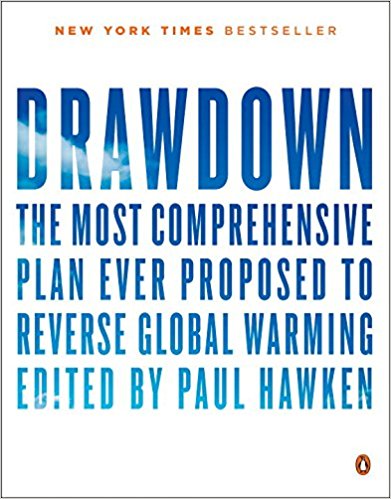Drawdown: The Most Comprehensive Plan Ever Proposed to Reverse Global Warming
Paul Hawken (editor)
Penguin Books, 2017
234 pages
My last couple of articles here have dealt with allowing ourselves to grieve for losses in nature, and discussing trauma and resilience in the time of climate change. I wanted to round out the trifecta with a more concrete set of solutions, and these come in the form of one of the best books I’ve read this year.
97% of scientists who are actually studying climate change (as opposed to making armchair claims) have found enough evidence to be convinced that climate change is anthropogenic–caused by humans. And the rate of climate change is so rapid on a geological scale that it’s set to seriously disrupt every system on the planet, from ocean currents to animal migrations to weather patterns. As I’ve mentioned before, this impending scene of doom–which we’re already seeing the first signs of–has a lot of people scared, anxious, angry, even hopelessly nihilistic. Much of that is because we don’t feel empowered to actually do anything, especially when government officials and corporations both seem hell-bent on continuing the trend in the name of money.
This book, then, is a serious antidote to that. The authors, who include some of the leading climate change researchers, as well as other people with boots on the ground studying its effects and contributing factors, have compiled a list of the 100 biggest contributors to climate change, ranked by the weight of their effect. More importantly, the book is full of both stories of people actively working to address these factors and work toward reversing climate change, and ideas on what everyday people can do to make a real difference. (If you aren’t able to get the book, the Drawdown website also has all the solutions on it for anyone to explore.)
The nice thing about the solutions is that it’s not just a matter of “You no longer get to have nice things because they harm the Earth.” A lot of it is just about improving the ways in which we manufacture, distribute and make use of resources. Granted, much of the burden is on the shoulders of the Western world since we have by far contributed the most to climate change. But there are also solutions that improve conditions for people in developing countries without increasing climate output. We’re not expected to all go live in tiny huts without electricity and running water; we just need to be wiser in our resource use.
The book is of course valuable for the dense wealth of practical knowledge it contained, written in an accessible format. What is of even more interest to ecotherapists, I think, is how this book may be used with clients who are experiencing distress due to climate change. Seeing that other people are working toward a better world can assuage some fears and worries, and comfort them in knowing that not everyone wants to see the world burn.
What I see as being even more valuable is the conversation that a client may have with their therapist, as well as friends and family, about what solutions they themselves can engage in. The client may choose to make a few life changes inspired by the book, or they might choose just one and make it their primary focus. Either way, that level of personal empowerment can be incredibly valuable, both for a client’s personal mental health, as well as their connection to a force for the greater good. (Ecotherapists may also find it useful to use the book in a similar fashion to boost resilience and improve overall mental health.)

